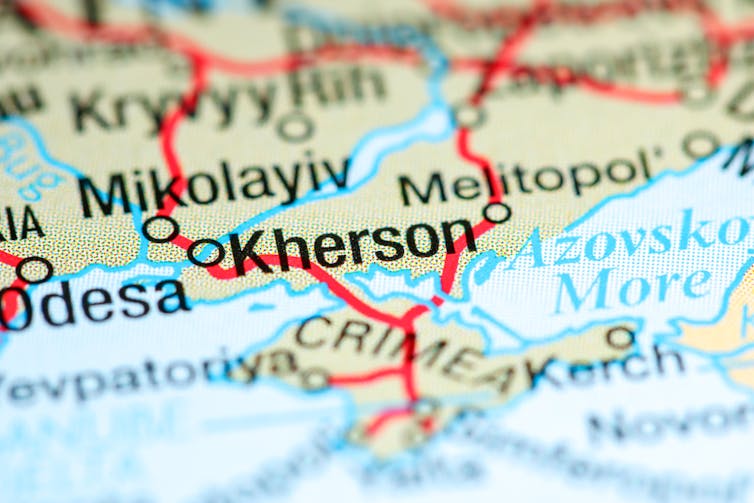It is a year now since Ukrainian forces liberated Kherson. I knew it before the war as a polyglot and bustling port city (if still determinedly Soviet in feel) sitting largely on the western (right) bank of the mighty Dnipro River.
In the first few days of the war, in February 2022, Kherson was seized by Russian forces. It was the largest and strategically most important Ukrainian city to come under Russian occupation. While a major administrative centre itself, Kherson also represented an important gateway for Russian forces in terms of their hoped-for later push towards the vital port city of Odesa, some 150km further to the west.
But the advance stalled and Russian forces had to relinquish control of Kherson some months later, in November 2022. By then, Ukrainian military pressure was making holding the city untenable. It made more operational sense for Russian forces to pull back across the Dnipro and to establish better defensive lines along the river’s eastern (left) bank.
Life, however, for Kherson’s inhabitants did not return to “normal” once liberation came on November 11 2022. Far from it. The city’s original population of 300,000 has dropped to around 71,000, and life for those remaining is hard.
Although no longer fearful of arbitrary arrest and detention by occupying Russian forces, such forces still pose a threat. They are now in positions just across the river and subject the city to almost daily bombardment.
Since Kherson’s liberation, around 200 of its inhabitants have been killed by shelling and missile fire. Venturing on to the city’s streets is dangerous – but there is little reason to go out anyway. Few shops and still fewer places of entertainment are open. Only three restaurants remain. There are also few factories and businesses operating.
The demographics have also changed, with mostly the elderly remaining while the young seek better lives elsewhere, taking their children with them. The city’s only real vibrancy comes from the many Ukrainian soldiers who, on any breaks from frontline duty, come into the city to unwind.

The tense atmosphere within the city is exacerbated by the feelings towards those citizens who are known or suspected to have collaborated with the Russian occupiers. Prior to its initial occupation, the city’s population was roughly 40% Russian speakers – although this can be no judge of where their loyalties lie. However, it was clear that some people leant towards Moscow and not to Kyiv.
Life was also made harder in Kherson by the Russian destruction, in June 2023, of the Nova Kakhovka dam across the Dnipro some 100km upriver from Kherson. The resultant catastrophic flooding of the city and surrounding land has been called “one of the biggest human-caused disasters of our time”.
As well as claiming the lives of some 80 or so people, it led to thousands of land mines being placed across a wide area – their presence will remain a major hazard for many years. A vast amount of pollution has also been caused by the flooding.
But perhaps the greatest long-term result of the destruction of the Kakhovka dam is the loss of the hydroelectricity supply it once generated. This means, in particular, that irrigation water can no longer be pumped into fields in three of the local oblasts (large administrative regions), including Kherson.
A million hectares of land will apparently be lost to agricultural production for the next three-to-five years. Kherson city, which relied for much of its economic vitality on being a major agricultural centre, will therefore likely remain economically moribund for years to come.
Russian threats
Efforts are currently being made to push Russian forces further back from the city, in the hope of putting it out of their artillery range. But these Russian forces have the benefit of being well dug-in just across the Dnipro in long-prepared defensive positions.
Nevertheless, over the last year, Ukrainian forces have been making numerous “nuisance” raids in light boats across the river into Russian-held territory. In October 2023, more substantial crossings resulted in small slivers of land on the east (left) bank, 20-30km upriver from Kherson city, coming to be held by Ukrainian forces.
But holding such slivers may be difficult in the coming weeks, as it proves hard to resupply the troops there, especially with ammunition. With no bridges still standing across the Dnipro, all support will have to come by small boat across the river.
Building any kind of pontoon bridge across a river as wide as the Dnipro is probably way beyond the capacities of the Ukrainian military. And anyway, such a bridge would be very vulnerable to both Russian ground fire and aerial bombardment. As things stand around Kherson, Russian forces can still call upon considerable groundfire assets and they also hold air superiority.
So, Ukrainian forces in this Kherson sector can probably only hope to make probing attacks over the coming months, not major advances. As such, the city’s inhabitants can expect no let-up in the Russian bombardment of Kherson. This will represent a trial, no doubt, but at least the Russians are no longer the occupiers. That has to come as no little comfort.
Rod Thornton ne travaille pas, ne conseille pas, ne possède pas de parts, ne reçoit pas de fonds d'une organisation qui pourrait tirer profit de cet article, et n'a déclaré aucune autre affiliation que son organisme de recherche.
This article was originally published on The Conversation. Read the original article.







